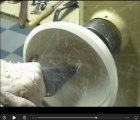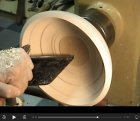I continue to practice turning as a new turner and enjoy bowls. Have turned a variety of wood in both wet and kiln dried. I have pretty well been able to clean up the end grain rough places on the exterior with power sanding. However, I struggle to get a nice smooth finish at those same spots on the interior. I have tried to turn the walls more but the very open grain seems to continue to no end. Sanding helps but still leaves clear evidence of the rough places.
Any suggestions for how to improve these places in my bowls?
Thanks.
Any suggestions for how to improve these places in my bowls?
Thanks.




